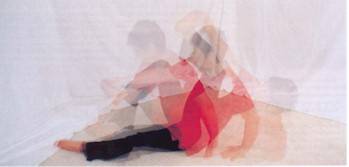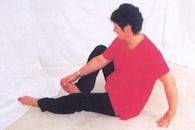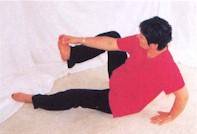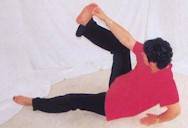Positive Health Online
Your Country

The Feldenkrais Method
listed in bodywork, originally published in issue 23 - November 1997
Several years ago on a Greek Island, I discovered Felden- krais, a technique of body awareness through gentle movement. Was this really me that floated through the departure lounge of Athens Airport? I couldn't believe the presence my new body commanded.
I had told Anthy, my Feldenkrais teacher from New York, 'I want to teach this'. But back home and back at work, I lost the energy of my statement. My experience turned into memories. Me, a landscape architect, change career so completely? But her response to me echoed in my brain: 'I heard you say "I want to teach Feldenkrais".' And why live if not to do what makes me feel alive?

Composite photograph showing Feldenkrais Method® movements
Several years on, I have completed the four year training in Strasbourg, and now work teaching Feldenkrais in the UK. Changing careers has been one of the best things I ever did.
'Felden-what?' do I hear you ask? Feldenkrais is the name of a method of self awareness through movement, and the method is called after the man who originated the concept, Moshe Feldenkrais (his name is pronounced to rhyme with rice).
Moshe Feldenkrais began his first North American training in June 1975 with the words "I am going to be your last teacher. Not because I'll be the greatest teacher you may ever encounter, but because from me you will learn how to learn, you will recognise that there are no teachers, only people learning and people learning how to facilitate learning."
What is it?
Feldenkrais invites you to learn how to move in a new way. It is a movement based solution to movement based problems. If you imagine a friend of yours walking down the street, and that all you can see is their silhouette – not the person, I imagine you would recognise them by the way they move. Our history is written in our bodies. How we habitually move, act and feel is a compilation of our life experiences and injuries.
The Feldenkrais profession spans two worlds or domains, the first is the realm of our experience and how we act through our senses, without diagnosis or analysis, and the second is the realm of learning. In these combined realms, both practitioners and their clients can have amazing new experiences of themselves, and shifts in self awareness and in patterns of moving, or in other words, learning.
Often we do things out of habit. Have you ever driven home and when you got there realised that you don't remember driving a large part of the way? You get out of the car and there are no animals or tree branches on the car bonnet, so you did make it home safely, but you simply don't remember how you got there. Doing things in this way is a strength. We don't have to re-learn how to drive a car every time we get in one. It is also a constraint. Doing things in the same habitual way, without awareness of how we are acting and moving, does not help us to learn how to do something in a new way. This could include learning how to sit at a computer and not get back pain, re-learn how to move after a stroke, or give a presentation and develop a body-rapport with the audience.
Feldenkrais teachers work with people in two ways, on a one to one basis and in groups. In both, the essence of what they do is a sequence of movements which invite the person to notice what they are doing, what other choices they have. The other choices include:
- a new range of movement
- a new quality to movement
- more co-ordination.
The idea is that you will change most easily if the new movements are easier than the old ones, and as Feldenkrais said: "If you know what you are doing you can do what you want."



Who can benefit from Feldenkrais?
People who can benefit from Feldenkrais include those who want to:
- improve body image
- improve posture
- improve voice projection, quality and pitch
- ease pain in the back, neck and shoulders
- learn how to avoid repetitive strain injury
- Feldenkrais can also be beneficial for those with central nervous system conditions, including multiple sclerosis, cerebral palsy and stroke
- in the workplace, Feldenkrais can be used to improve self awareness in presentation skills.
Feldenkrais is a movement based solution to movement based problems. It improves freedom of movement and flexibility.
How the Feldenkrais Method developed
Feldenkrais himself was a physicist and engineer. He was also a black belt in Judo, and introduced Judo into Paris in the 1930s. He combined his knowledge of Newtonian mechanics, physics, neuro-physiology, systems thinking and learning theories with the eastern philosophy of Judo.
Feldenkrais moved to Israel when he was very young, and he became interested in self defence, and studied Jujitsu. When he moved to Paris, he went to a demonstration in Judo by Professor Kano then Japanese Minister for Education, and subsequently established Judo in Paris in the 1930s.
While in Paris, he studied engineering and, on graduating became a research associate in nuclear fission, with Frederic Joliot-Curie, in the laboratory made famous by Madame Curie.
The method began by Feldenkrais asking questions such as: what is the optimum organisation of a human being for acting in the world and in gravity, and how should the skeleton function? He explored the connections between physics and Judo, and through this demistified the abilities of people who practise martial arts.
He then began to work with people on an individual basis, and noticed what kind of contact and internal attitude on his part, best allowed an individual to learn.
He continually experimented, and, when he taught a class, would tape it and then use the tape for the next class, refining the wording according to the response. He came to realise that when people focused more on the goal rather than the process, the kind of learning he was after didn't happen.
The development of his approach is shown in the books he authored during his lifetime, and he developed several thousand lessons. Lessons range from those with small eye movements, breathing to dynamic bending, twisting and rolling lessons. Towards the end of his life he ran three training courses in America, starting in 1977. People who trained with him are now continuing to take the work forward, and train others. Around the world there are approximately 3000 practitioners, with in the region of 3000 students currently in training. So it is fast gaining momentum.
Scientific background
As a scientist, his experimenting was careful and methodical. But his work was not compatible with classic science. He couldn't take his experiments into the laboratory because for him there were no distinctions between mind and body. The kind of learning he was after was phenomenological, which is learning by sensory experience, before we put words on it, interpret or create ideas for it.
When Feldenkrais died in 1984, there was very little scientific evidence to corroborate how Feldenkrais lessons work. At this time, cognitive science was largely based on a computational model of thinking, which still echoes in our language today. He was ahead of his time.
The alternative to the computationalist view is the embodied point of view as expounded by Francisco Varela. He sees the mind as 'embodied', or in other words, perception, action and sensory motor processes being inseparably linked as an organism interacts with its environment. Varela's work belongs to the tradition of Phenomenology, which regards first person accounts of their experience as valid.
Feldenkrais practitioners and their clients know that the process works. There are many examples of first person accounts of effects and results. However it is difficult to measure in the traditional sense, by a cause and effect relationship with clinical trials.
Feldenkrais and Presentation Skills
"Frequently the human animal... concentrates so hard on his words that he seems to forget that
his movements, postures and expressions are telling their own story."
Desmond Morris
Several studies have shown, and all producing similar figures, that only 7% of the information which we take in, when a person is speaking, is verbal. The remaining 93% is non-verbal, comprised of 55% visual and 37% vocal (including volume, inflection and pace). Only 7% of what we experience when a person is talking is based on the choice of words, style and language.
In a presentation skills workshop, experiential Feldenkrais lessons are interwoven with factual information on how to put together the contents of a presentation. Feldenkrais lessons are included to highlight the difference between how a person experiences his or herself, and how the group perceived them giving a presentation. Lessons are then used to improve the voice, posture, eye contact with the audience and breathing, as well as connecting to the biological roots of how our body reacts to stress.
How practitioners train
To practise, Feldenkrais practitioners must complete a four year training course of 800–1000 hours. The main purpose of the training is for practitioners to learn to develop a deep awareness of their own movement and its formation and potential. Students learn to become astute observers of the movement of others. They also learn to teach both groups and individuals how to develop their own movement and awareness skills.
Practitioners come from all kinds of backgrounds. Some are scientists, doctors or physiotherapists. Others are actors, dancers or performers of some kind. Others are teachers, while some are studying straight from school.
Most of the training courses around the world are for 8 weeks a year, over a 4 year period, with study group work between segments. This allows a person to maintain a job at the same time. Some training courses in the US are centred on a series of weekends through the year. New courses regularly start in the UK, France, Germany, Switzerland, Sweden, Italy, Australia, Canada and in the United States. Courses are affiliated to the International Feldenkrais Federation, and many countries have Guilds.
So, summing up, Feldenkrais is an attitude. It teaches body awareness through movement, and how to learn, and can be applied to any profession or action in life!
References
The Embodied Mind: Cognitive Science and Human Experience, Francisco Varela, Evan Thompson and Eleanor Rosch. MIT Press 1991
Moshe Feldenkrais, Awareness Through Movement: Health Exercises for Personal Growth. London, Penguin Books, 1980
Carl Ginsburg, Keynote Address, Report of the European Feldenkrais Conference, Heidelberg 1995
Francisco Varela, Large Scale Integration in the Nervous System and Embodied Experience, Report of the European Feldenkrais Conference, Heidelberg 1995
Further Information
Feldenkrais Method® is the registered trademark of the Feldenkrais Guild UK Ltd., PO Box 370, London N10 3XA.
Comments:
-
No Article Comments available